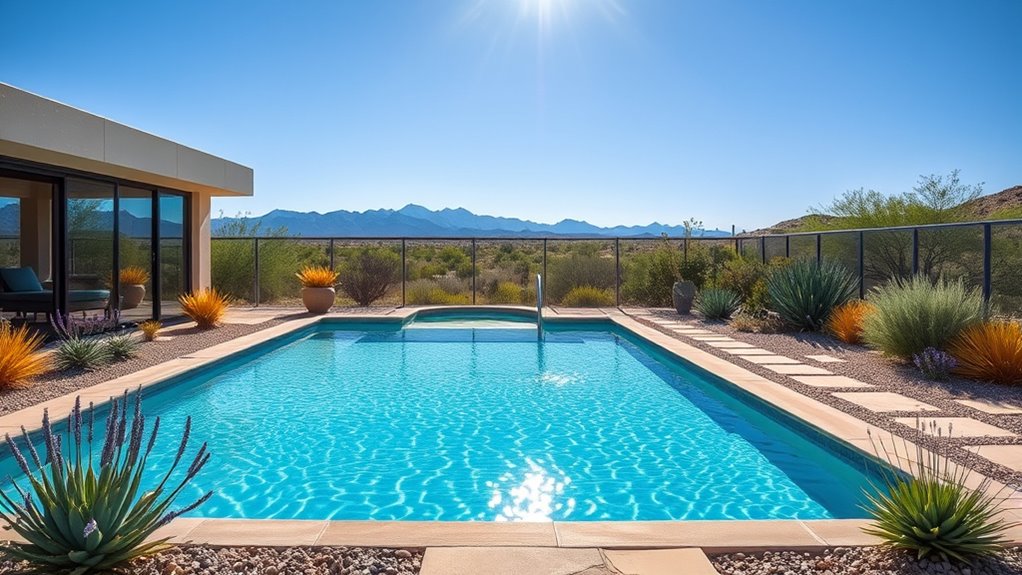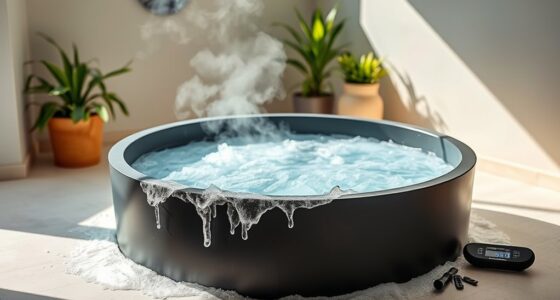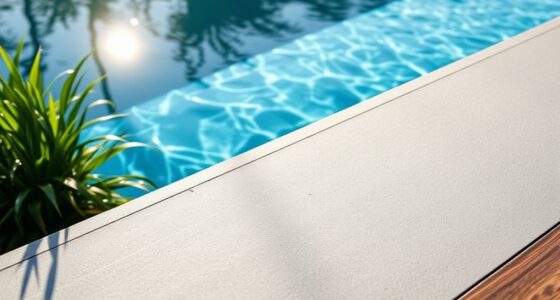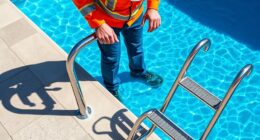Climate-adaptive pool designs, like retractable enclosures and drought-friendly features, let you enjoy your pool year-round while conserving resources. Retractable enclosures protect the pool during cooler months and open up for fresh air and sunlight on warm days. Pairing these with drought-resistant plants and efficient water management reduces water usage, while solar heating and smart covers save energy. Keep exploring to discover how these innovative features can make your outdoor space more sustainable and flexible year-round.
Key Takeaways
- Retractable enclosures enable year-round pool use by adapting to seasonal weather conditions and maximizing outdoor enjoyment.
- Solar heating systems integrated with pool covers reduce energy costs and promote eco-friendly, sustainable pool operation.
- Pool covers help conserve water and energy by retaining heat, reducing evaporation, and minimizing debris entry.
- Designing smaller, efficient pools with smart technology enhances water and energy efficiency, supporting climate resilience.
- Combining retractable enclosures and drought-friendly features creates adaptable, sustainable pools suited for varying climates and water conservation needs.
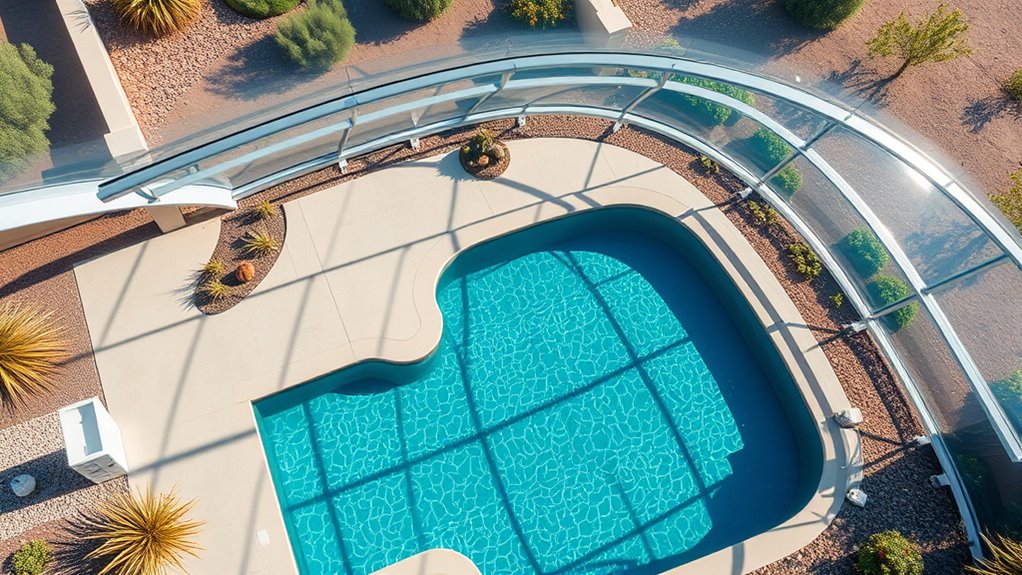
Are you looking to transform your backyard into a stylish oasis? If so, embracing climate-adaptive pool designs can make your outdoor space both functional and sustainable. One smart approach involves using retractable enclosures, which allow you to enjoy your pool year-round while protecting it from the elements. These enclosures can be opened on warm days for an open-air experience or sealed during cooler seasons to retain heat and keep debris out. They’re especially effective in regions with fluctuating weather, giving you maximum flexibility. Pairing these enclosures with solar heating systems can further enhance efficiency, harnessing the sun’s energy to warm your pool naturally. Solar panels integrated into your pool cover or nearby can considerably reduce energy costs, making your outdoor retreat eco-friendly and budget-conscious.
Pool covers are another essential element in climate-adaptive designs. They serve multiple purposes: retaining heat, reducing evaporation, and minimizing debris. During colder months or nights, a high-quality pool cover traps the heat accumulated during the day, keeping your water warm and ready for use when you want it. This is particularly useful if you opt for solar heating, as the cover helps maximize the energy absorbed from the sun. In drought-prone areas, pool covers also conserve water by reducing evaporation, which is fundamental when water restrictions are in place. Using a cover consistently means less water needs to be added, lowering your overall water footprint. Additionally, pool covers prevent dirt, leaves, and critters from contaminating the water, reducing the need for chemicals and cleaning.
Designing your pool with drought-friendliness in mind means selecting materials and features that minimize water and energy use. Choosing a smaller, more efficient pool size can be more sustainable, as it requires less water to fill and maintain. Incorporating smart technology, like automated covers and temperature controls, helps you manage your pool’s climate with precision, reducing unnecessary energy consumption. When combined with solar heating and quality pool covers, your backyard becomes a resilient oasis that adapts seamlessly to changing weather patterns and water availability. This approach not only enhances your outdoor experience but also helps you live more sustainably. With these climate-adaptive features, you’ll enjoy a beautiful, functional pool that’s aligned with your environmental values and local climate challenges.
Frequently Asked Questions
How Much Do Climate-Adaptive Pool Enclosures Typically Cost?
You’ll typically spend between $10,000 and $50,000 on climate-adaptive pool enclosures, depending on factors like size, design, and material options. Consider your cost considerations carefully, as materials like acrylic or polycarbonate can influence the price, with higher-end options offering better durability and climate control. Retractable enclosures tend to cost more upfront but can save you money long-term by reducing maintenance and energy costs.
Are Retractable Enclosures Energy-Efficient in Various Climates?
Retractable enclosures are generally energy-efficient across various climates because they provide solar shading and thermal insulation. During hot weather, they block direct sunlight, reducing cooling costs, while in cooler months, they trap heat, lowering heating needs. You’ll find that their ability to adapt to changing weather conditions helps you save energy year-round, making them a smart, eco-friendly choice for maintaining comfortable pool environments in diverse climates.
What Maintenance Is Required for Drought-Friendly Pool Designs?
Drought-friendly pools demand some TLC, but it’s no grand chore. You’ll need to regularly check your pool chemical balance—because pristine water is the goal, not a science experiment. Don’t forget enclosure cleaning; dust and debris love to settle. These simple tasks keep your eco-friendly pool looking sharp and functioning smoothly, proving that saving water doesn’t mean sacrificing sparkle or ease. Who said sustainability couldn’t be hassle-free?
Can These Pool Designs Be Customized for Small Spaces?
Yes, these pool designs can be customized for small spaces. You’ll find great design flexibility, allowing you to maximize limited areas efficiently. With options like compact shapes, foldable enclosures, and smart layout choices, you can create a functional, attractive pool that fits your yard perfectly. This customization guarantees you enjoy all the benefits of climate-adaptive features without sacrificing space or style.
How Long Do Climate-Adaptive Enclosures Usually Last?
Your enclosure can last for decades, often outliving regular structures, thanks to exceptional material durability. Most climate-adaptive enclosures are built with high-quality, weather-resistant materials that withstand harsh sun, wind, and rain. Proper maintenance can extend their lifespan even further. Typically, you can expect these enclosures to serve you 15-25 years, making them a smart investment that offers long-term protection and adaptability for your pool, no matter the climate.
Conclusion
Imagine a pool that transforms your backyard into a year-round paradise, no matter the weather or drought conditions. With climate-adaptive designs like retractable enclosures and drought-friendly builds, you’re not just saving water — you’re revolutionizing your outdoor space into an unstoppable oasis. Say goodbye to wasted resources and hello to endless summer fun, all while protecting our planet. This isn’t just smart design; it’s the future of pools, and you’re at the forefront of the revolution!
